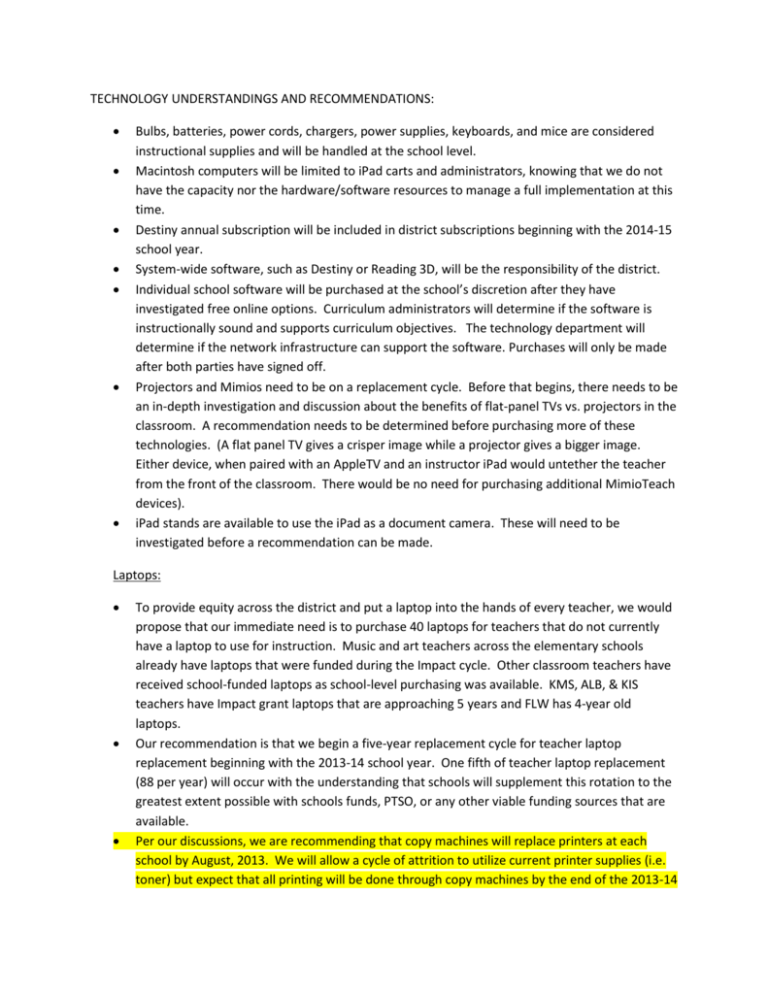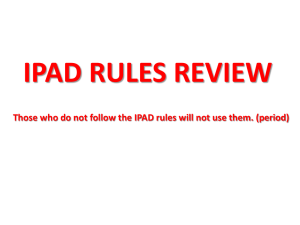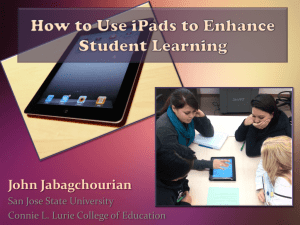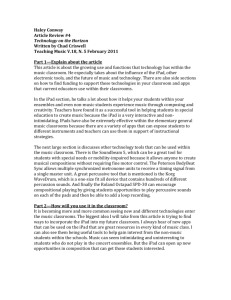TECHNOLOGY UNDERSTANDINGS AND RECOMMENDATIONS
advertisement

TECHNOLOGY UNDERSTANDINGS AND RECOMMENDATIONS: Bulbs, batteries, power cords, chargers, power supplies, keyboards, and mice are considered instructional supplies and will be handled at the school level. Macintosh computers will be limited to iPad carts and administrators, knowing that we do not have the capacity nor the hardware/software resources to manage a full implementation at this time. Destiny annual subscription will be included in district subscriptions beginning with the 2014-15 school year. System-wide software, such as Destiny or Reading 3D, will be the responsibility of the district. Individual school software will be purchased at the school’s discretion after they have investigated free online options. Curriculum administrators will determine if the software is instructionally sound and supports curriculum objectives. The technology department will determine if the network infrastructure can support the software. Purchases will only be made after both parties have signed off. Projectors and Mimios need to be on a replacement cycle. Before that begins, there needs to be an in-depth investigation and discussion about the benefits of flat-panel TVs vs. projectors in the classroom. A recommendation needs to be determined before purchasing more of these technologies. (A flat panel TV gives a crisper image while a projector gives a bigger image. Either device, when paired with an AppleTV and an instructor iPad would untether the teacher from the front of the classroom. There would be no need for purchasing additional MimioTeach devices). iPad stands are available to use the iPad as a document camera. These will need to be investigated before a recommendation can be made. Laptops: To provide equity across the district and put a laptop into the hands of every teacher, we would propose that our immediate need is to purchase 40 laptops for teachers that do not currently have a laptop to use for instruction. Music and art teachers across the elementary schools already have laptops that were funded during the Impact cycle. Other classroom teachers have received school-funded laptops as school-level purchasing was available. KMS, ALB, & KIS teachers have Impact grant laptops that are approaching 5 years and FLW has 4-year old laptops. Our recommendation is that we begin a five-year replacement cycle for teacher laptop replacement beginning with the 2013-14 school year. One fifth of teacher laptop replacement (88 per year) will occur with the understanding that schools will supplement this rotation to the greatest extent possible with schools funds, PTSO, or any other viable funding sources that are available. Per our discussions, we are recommending that copy machines will replace printers at each school by August, 2013. We will allow a cycle of attrition to utilize current printer supplies (i.e. toner) but expect that all printing will be done through copy machines by the end of the 2013-14 school year. The technology and business operations directors along with the school administration will tour each school and determine the best location for the copier/scanner/printers. If additional network drops are required, a list of those locations will be compiled and given to a selected network contractor to complete. iPads This year 20 iPad carts were placed throughout the school system. The only grade level that does not have an iPad cart is 7th grade. ALBHS – Science (Rodgers), Fine Arts (Snyder, Peterson), Social Studies (Bryant), Media Center and ALC KMS – Tech Ed (Braswell), Language Arts (Britt & Fulton) KIS – A Pod (5th grade) and G Pod (6th grade) FP – Kindergarten (shared) and 4th grade shared between (Motley & DeCoux) FLW – First grade (Suarez) and Media/Technology JP – Third grade (Lane) SB – First grade (Bainbridge) WW – Second grade (Summerlin) McK – Lentz (3 year olds) RECOMMENDATIONS: We need to decide if leasing iPads is a viable choice. The interest rate is a prime minus 1%. Dr. Cain will meet with Will Crabtree to determine if leasing is appropriate for Kannapolis City Schools. Here are our iPad recommendations: 1. KMS - Purchase an iPad cart (30) for 7th grade use in social studies (Waugh). 2. Next, to assist with instruction and assessment in grades 3-8, we will place iPad carts when financially possible in all classrooms starting with third grade and working up to eighth grade. Elementary carts will contain 25 iPads. Middle school and high school carts will contain 30 iPads. a. Third grade will require 9.5 iPad carts to achieve a 2:1 ratio. FP – 6 (3), FLW – 3 (1), JP – 4 (2), SB – 3 (1.5), WW – 4 (2). The first number represents the number of classrooms in third grade. The second number represents the number of iPad carts that would be b. purchased by KCS per school to achieve a 2:1 ratio. c. KIS – Since KIS has a steady revenue stream from PTSO, we recommend that the school look to lease-purchasing within their financial constraints up to 3 iPad carts with 25 iPads per cart. The district would match their lease amount. d. KMS – two additional iPad carts with 30 iPads per cart. e. ALBHS’s media and technology committee has recommended the following for iPad growth in their building: i. Add 5 iPads to Daniel Bryant’s cart ii. iii. iv. v. vi. iPad cart for Jennifer Ward (20) iPad cart for Norma Alava (20) iPad cart for Leah Buckner (15) iPad cart for Lynn Efird (20) Add 10 iPads to Jeremy Peterson’s cart Desktops: Replacing desktops will be on hold until further testing has been conducted. We need to determine if virtual clients are a viable option or if the plummeting cost of desktop computers is a better fiscal choice. Supporting a virtual client is simpler because the changes are made once on the server, vs. on each computer but if the server isn’t robust enough, the sluggish performance will discourage the use of technology by staff and students.





